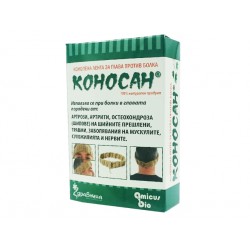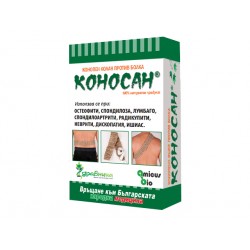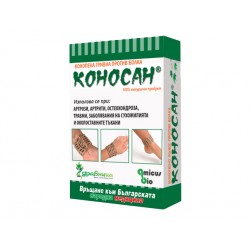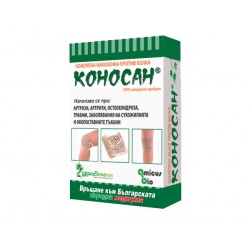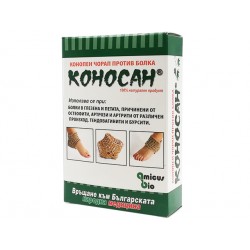Dr. Ilija Bivolarski, creator of the 7 products "Konosan" about the healing properties of hemp, hemp rope, and hemp belt in a special interview with "Zdravnitza".
- Dr. Bivolarski, how did you "remember" hemp and its medicinal properties at a time when it was forgotten and even banned?
In the summer of 2004, I met a friend of mine who complained to me that a month ago he had lower back pain that appeared after heavy physical exertion. The pains were severe, spreading to one leg. He couldn't sleep for several nights, had difficulty moving, and was limping. He went to several medical specialists, they did various tests and they did not find anything serious. One diagnosed him with lumbago. Another told him he was suffering from sciatica. The pains were not significantly affected by the drugs and physical therapy procedures that were prescribed to him.
Then my friend remembered that his grandfather treated his back pain himself with a rope woven from ordinary hemp, which he "processed" in a specific way, without the use of any chemical substances. When it was "worn out" and stopped working, his grandfather wove a new rope. Almost desperate, my friend decided to try his grandfather's method of treatment. One evening he found a ball of twine in the cupboard, wove a rope, processed it according to his grandfather's recipe, tied it around his waist, and went to sleep. In the morning, when he got up to go to the toilet, he found to his great astonishment that the pain had disappeared. Nothing hurt him - not his back, not his legs, not even a limp.
The whole time he was passionately explaining his story to me, I listened to his story without much interest, impressed only by his intense excitement and his wide eyes, which insisted on watching me to see if I was paying attention to what he was saying. He was so enthusiastic that he repeated to me three times how the twine rope was "worked" to make it work better. We chatted some more and parted ways.
Two days after meeting him, I had taken my son for a walk in the park near the house where we lived. Two grandmothers were sitting on one of the benches talking. The kid decided to kick the ball right at them and refused to move. I forced myself to stand with the women in front of the bench to protect them from a more strongly kicked ball. I listened to what they were saying and at one point I was startled. Same story - hemp ropes that cured back pain. Different "protagonists", similar experiences, same plot. I felt like someone was patting me on the head to pay attention to the topic being discussed.
The two incidents impressed me so much that I thought about the healing effect of the hemp rope all summer and finally decided to participate in this topic in a research project at the Medical University - Plovdiv. I had to come up with a name for the product. I decided it should be a combination of the words "hemp" and "sano" (from Latin - heal). At that time, I had ten years of experience as an assistant in the Department of General and Clinical Pathology. At the beginning of the academic year, after an extensive bibliographic reference, I wrote the project, included the research team colleagues from other specialties, and submitted it to the Council of Science at MU-Plovdiv. The project received a very good rating. They invited me to report on the subject in the Plovdiv branch of the Union of Scientists in Bulgaria (SUB). From there they issued me an information card and registered it with the National Exchange for Intellectual Products. This was followed by notarizations, a certificate from the Patent Office - Plovdiv, Certificates from the Agency for the Protection of Intellectual Property, a certificate, and a certificate from the Patent Office of the Republic of Bulgaria.
This is how the story of Konosan hemp products began. They are produced from cultivated hemp approved for industrial production. It lacks the psychoactive component of cannabis - tetrahydrocannabinol (THC), which, according to international standards, must be below 0.2% in cultivated hemp. On the other hand, cultivated hemp contains other chemical substances (cannabinoids) with a pronounced anti-inflammatory and pain-relieving effect. These ingredients are extracted in various forms (alcoholic extracts, creams, oil solutions) and are used in pharmacy to alleviate the condition of patients suffering from a wide range of diseases.
- How many years have your "Konosan" brand products been on the market and what is the feedback from patients?
The beginning was made 20 years ago with the registration of the first "Konosan®" product - the hemp rope. After a while, I started thinking about a product that would cover a larger surface area than the back and waist and, accordingly, would have a faster and more efficient action. This is how the idea for the Konosan® hemp belt was born. After him, the products for joints appeared - the knee brace, the bracelet.
At that time I often had headaches, and one day, coming home from work, I had the idea of wrapping a hemp rope around my forehead and temples like a headband to test its effect. Lost in my homework, I forgot about both the headache and the rope around my head. The doorbell rang and I went to open the door. The neighbor was standing outside, who tried to say something, and, looking at me, remained open-mouthed. I asked him what happened and he pointed to my head and asked, "What's that?". Only then did I remember what I looked like. That's how the Konosan headband came about.
5-6 years ago, in several months, inquiries became more frequent about which product could be used by patients suffering from rheumatoid arthritis with severe pain in the palms and fingers. There were also questions from people with heel pain about what product to use and how to put it on their heel. These patients were the reason behind the appearance of the Konosan® glove and the hemp sock.
- Which of the types of "Konosan" is the most used and what are the reasons in your opinion?
- There are seven Konosan® products. In the last 3-4 years, the hemp belt has been the most sought-after. This is probably due to the higher frequency of problems with the spine and adjacent tissues, compared to other diseases of the musculoskeletal system. Apparently, with good reason, some medical specialties consider diseases of the spine as the root cause of the development of a large number of diseases in human pathology, including several diseases of the internal organs. Several treatment techniques are based on this concept, primarily aimed at restoring the mobility and flexibility of the vertebrae of the spine.
In second place in demand is Konosan® hemp rope. This is the first product that has been on the market for the longest time, therefore it is also the most famous. Another characteristic of it is the possibility to place it on almost all parts of the body, including areas for which other Konosan® products are intended.
- What are the most common mistakes that people who use them make? For example, they bathe with the hemp belt, etc., about which you warn.
- For the fact that wetting is not desirable, there are instructions in the application leaflet for each product. This is because the fine hairs of the fibers stick together and the effect of the product decreases sharply. I have had patients ask if they can wash the product, dry it, and then use it again. After all, washing it will have the same effect as when it gets wet.
A common problem is the parallel use of creams and ointments in the same areas where the products are applied. In these cases, I recommend removing the hemp product, waiting as long as necessary for the cream to absorb well, and only when the skin is completely dry, then applying Konosan® again.
- After years of using your products, what advice would you give them?
- The most common question people ask is: "How long should I wear it?" The answer is: "You decide." There is no dosage. It's different for every person.
Some put them on the painful part of the body and forget about them. After a few days, when their relief is permanent, they take them off, put them in the cupboard, and use them again if necessary. This is the sensible way to use it, in my opinion.
Others continue to wear them long after they get relief. It's not a problem, but it's redundant. With continuous use, after about a month and a half, the product becomes smooth and shiny, its hairs disappear and it stops working.
Individual patients have called me saying that their pain has worsened after having the product inserted. This possibility is also described in the instructions for use as a condition similar to a "treatment crisis". This is usually an indication that the product will work well for them, but if they can't tolerate it, they can take it off and on for some time until they adapt.
It is not a good idea to do your loved ones a favor by giving them your Konosan for temporary use. Its effect may be significantly reduced. Also, would you wear someone else's used underwear?
In conclusion, I would like to emphasize that Konosan® products are not medicines! If you have health problems, seek help from a medical professional, and do not resort to self-medication!
The use of the product does not replace the procedures prescribed by your doctor. Do not stop taking your prescribed medications without consulting your doctor. Konosan® does not cancel other treatment methods, does not contradict them, but only complements them by accelerating the healing process!




